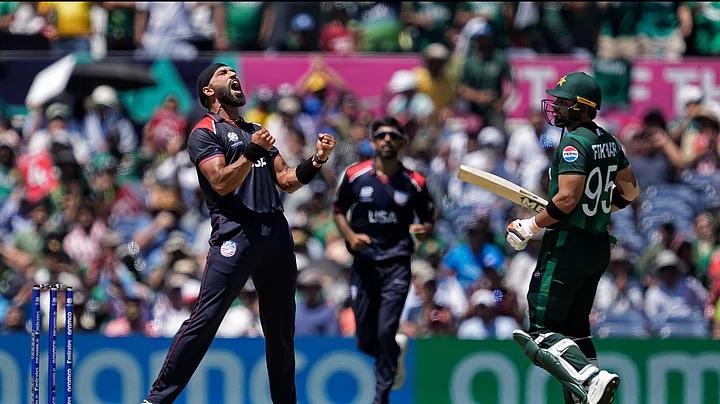On 6 June, when the US Cricket team defeated heavyweight Pakistan in a nail-biting super over of a T20 World Cup match, social media users started to dig out the nationalities of the winning team's members.
They found that the US squad includes 11 players born in India or children of Indian migrants, as well as others from Pakistan, Nepal, and Sri Lanka.
When netizens discovered that the US squad had a significant number of Indian players, Indian parliamentarian Dr Shashi Tharoor posted on the X platform, “As some brilliant wag also put it: Not the Indian A team, not the Indian B team, but the Indian H1B team!”
Indeed, fast bowler Saurabh Netravalkar of the US squad is a software engineer with Oracle on an H1B visa from India. His teammate, Ravi Timbawala, who spent his teenage years in India, is now a manager at Foothill Pharmacy in California. Additionally, the team captain, Monank Patel, is an Indian who holds a Green Card (permanent residency in the US).
Batting first in the super over, the US scored 18-1, with vice-captain Aaron Jones contributing 11 runs before being run out. Aaron, a Barbadian born in the US, is of African, i.e., mixed-race descent. Seven runs were added via extras. In response, Iftikhar Ahmed took Pakistan to 5-0 off two balls in their super over before being brilliantly caught by Nitish Kumar near the boundary.
US bowler Saurabh Netravalkar then restricted Pakistan to 13-1.
On Wednesday, the US will play against India. If India wins, they will all but secure a place in the Super 8 due to their high net run rate. If the US wins, they too will likely qualify, making it almost impossible for Pakistan to advance to the next round.
Win or lose, the match will be interesting to watch as Indians in the US clash with Indians in India.
Interestingly, out of the 17-member US Women's Cricket team, 13 are either Indians or Indian-origin players.
Look at Migration in the Football World
Not only in cricket, but even in the previous FIFA World Cup editions, migrants had played a vital role.
In the 2022 FIFA World Cup, 130 players, or about 16 percent of all the 32 teams, were migrants or children of migrants. In 2018, out of the 32 teams that participated, 22 fielded at least one foreign-born player. That year, when France lifted the Cup, US-based South Africa-born comedian Trevor Noah said, “Africa won the World Cup! Africa won the World Cup."
According to a 2019 study, there are three main football migration corridors.
The first is linked to colonialism, with migration occurring between colonisers and colonies, primarily between France and Africa, and also from South America to Europe.
The second corridor is based on geographical proximity, with migration occurring within Europe.
The third is the guest worker migration corridor, exemplified by Argentina-Italy, Germany-Turkey, and the Netherlands-Morocco.
Additionally, an analysis of the backgrounds of many migrant players reveals that poor economic conditions and civil war in their home countries have also driven them to migrate to richer and more stable countries.
At the first FIFA World Cup in 1930, around five percent of players represented countries that were not the nations of their birth. By the time of the 2022 FIFA World Cup in Qatar, 16.5 percent of all players, as iterated above, were born in countries other than the ones they represented.
Qatar, which hosted the FIFA 2022 World Cup, had a team in which 38 percent of the players were not native-born Qataris.
India Remains Largest Migrant-sending Country, US Remains Largest Migrant-hosting Country
All this proves once again that migrants shape the world, bringing honour to their host countries and pride to their home countries, even in the realm of sports.
Whether for pure survival or success, the number of people on the move is increasing. When they migrate, they take their talents and potential with them, naturally contributing to the benefit of their new homes.
When it comes to sports and citizenship, the practice of naturalising talented individuals from other countries to represent their new nations in international competitions dates back to ancient Greece.
China, often topping the list of medallists in the Olympics, is known for granting citizenship to athletes who can bring glory to the country as the Olympic Charter stipulates that to compete on a national team, athletes must obtain the nationality of that country.
According to the UN’s Migration Report 2024, there are 281 million international migrants globally in 2020, which is 3.6 percent of the world’s population.
The report also reveals that India remains the largest migrant-sending country, and the United States is the largest migrant-hosting country. Additionally, the report adds that India is the largest remittance-receiving country, while the US is the country with the largest outward remittance.
In 2022, India received more than $111 billion as remittances, the first country to reach and even surpass the $100 billion mark.
(Rejimon Kuttappan is an independent journalist, labour migration specialist and author of Undocumented [Penguin 2021]. This is an opinion-explainer piece and the views expressed above are the author’s own. The Quint neither endorses nor is responsible for them.)
